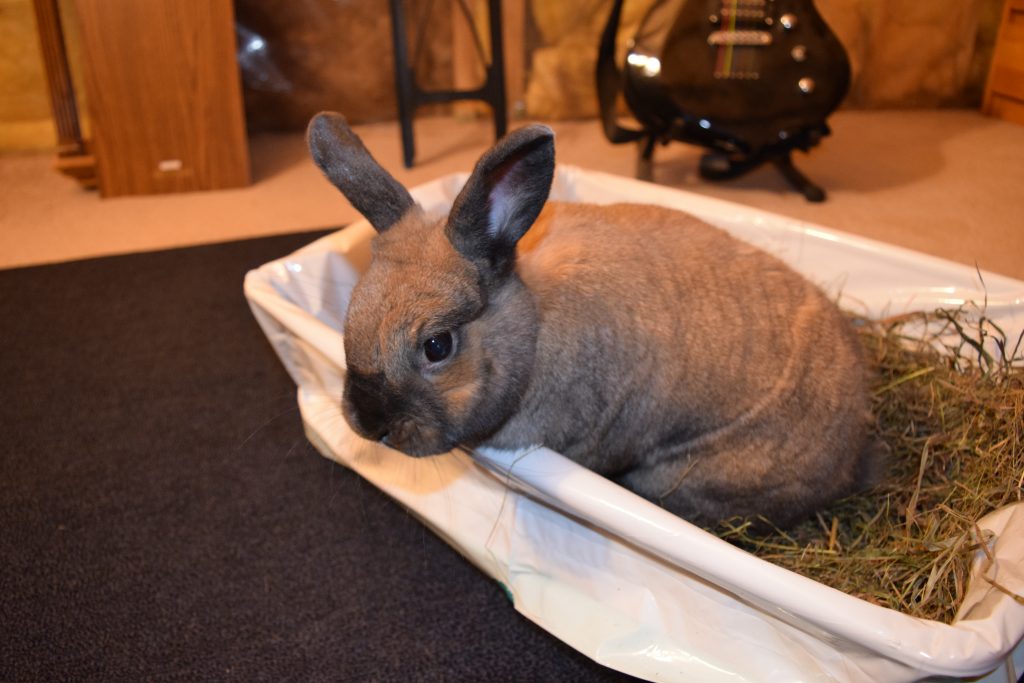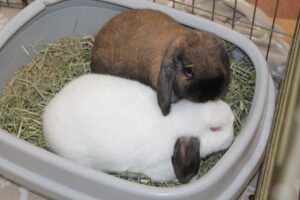The Basics
Rabbits litter-train easily if you understand rabbit logic. The greatest key to success is to spay or neuter your rabbit. This reduces the hormone surges that drive territory marking. Rabbits are neat by nature and will chose only 1-2 spots to urinate in. They also prefer to eat and defecate in the same location; indeed, it’s natural for rabbits to consume some of their hard pellets and all of their soft cecal pellets. You can use this natural behavior to encourage good litter habits: place hay inside of or hang it above the rabbit’s litter box.
A variety of materials can absorb urine; some are safer than others. Good choices include compressed wood pellets (wood stove fuel or Feline Pine), and recycled paper products(yesterday’s news, Care Fresh). Do not use grain based litters such as oat hulls, wheat, corn or citrus peels. If your rabbit likes to eat these litters, they are not digestible and can cause impactions. Never use cedar or pine shavings, because they give off natural toxins that cause respiratory and other health issues. Some rabbits are picky about their litter; you may need to experiment to discover her preferences. Most rabbits do not like the texture of cat litter, and it is dangerous if ingested. Clumping cat litter is especially dangerous because it can cause impaction if ingested.
When rabbits break litter training, search for a reason. Common ones include: urinary tract infection, new/disliked litter, infrequent changing of litter box, family stress, injury or disease causing incontinence, or boredom. Rabbits with true incontinence are treated with medication; rabbits who have lost bladder control are easily diapered. Please go to San Diego House Rabbit Society for further information.
To train your rabbit to their new litter box, keep them inside the new enclosure for the first week and restrict outside cage time to 10-20 min at a time. Hay in the litter pan or hung in a hay rack above the litter pan reinforces good habits. Gradually add space to their territory, one room at a time. Anticipate your rabbit, and if they back up and lifts their tail, transfer them back to the cage litter box immediately. It does no good to scold afterward, as your rabbit cannot link the behavior to punishment. For the first several days, your rabbit will naturally scatter poops everywhere to mark their new territory; if this doesn’t stop in a neutered rabbit, then territory restriction and retraining may be necessary. It doesn’t hurt to change litter daily. Many rabbits will complain if the box isn’t changed every 2-3 days.
Toilet Accidents
Rabbits make up to 200-300 hard poops daily! A few are bound to escape. A small vacuum (Dust-Buster, Dirt Devil) makes cleaning these up a cinch. To clean urine accidents, wipe immediately with water. Remove dried urine with a vinegar/water solution; rabbit urine is rich in calcium salts and the vinegar readily dissolves this.
Cecal Pellets
Rabbits produce a second, soft “poop” called a cecal pellet (also called “cecotrophs”) that looks like a tiny cluster of shiny grapes. You will seldom see these as rabbits re-ingest them immediately unless there is a diet problem (see Diet). True diarrhea, a vet emergency, is very soft or runny and lacks the cluster appearance. Cecal pellets are rich in vitamins and amino acids; rabbits who cannot reach them (e.g. paralysis) should be fed them. Cecal pellets are usually produced twice daily, usually 4 hours or so after mealtime. Some rabbits will overproduce cecal pellets when fed a protein- or sugar-rich food; in these instances, reducing/removing pellets or treats, or feeding only clean hay for several days often resolves the problem.
For more information on rabbit poops go to Triangle Rabbits.


